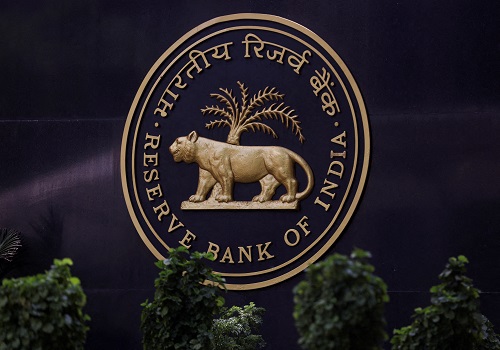Jeera trading range for the day is 20980-21980 - Kedia Advisory

Gold
Gold prices climbed 0.8% to settle at Rs.88,726, driven by heightened safe-haven demand amid escalating Middle East tensions and uncertainty surrounding U.S. President Donald Trump’s tariff policies. Investor focus also shifted to the U.S. Federal Reserve’s upcoming decision, with expectations of steady rates after three cuts in 2024, and potential easing resuming by June. China’s gold market showed robust performance, fueled by record ETF inflows in February and a positive economic outlook supporting jewelry demand recovery. The People’s Bank of China continued its gold-buying spree for the fourth consecutive month, bringing reserves to an all-time high of 2,290 tonnes - accounting for 5.9% of total foreign exchange reserves - with a 10-tonne increase in early 2025 alone. In India, record-high gold prices dampened demand, leading to widening discounts of up to $39 per ounce, the steepest in eight months, compared to $10-$21 last week. February imports are projected to plummet by 85% year-on-year to a two-decade low. The World Gold Council forecasts a moderation in India's 2025 gold consumption, ranging between 700-800 tonnes, down from 802.8 tonnes in 2024, driven by weaker jewelry demand despite a surge in investment appetite for ETFs, digital gold, and physical gold assets. On the technical front, fresh buying emerged with a 1.71% rise in open interest to 14,015 contracts. Gold finds immediate support at Rs.88,370, with a potential dip to Rs.88,015 if breached. Resistance stands at Rs.88,965, and a breakout could drive prices to test Rs.89,205.
Trading Ideas:
* Gold trading range for the day is 88015-89205.
* Gold rallied as investors sought cover from economic concerns fuelled by U.S. President Donald Trump's tariff policies.
* ANZ raised its zero to 3-month gold price forecast to $3,100 per ounce and 6-month forecast to $3,200 per ounce.
* China sees record gold ETF inflows in February, jewelry demand should stabilize as the economy improves – WGC
Silver
Silver prices climbed 0.73% to settle at Rs.101,269, driven by renewed safe-haven demand amid escalating geopolitical tensions and tariff uncertainty. U.S. President Donald Trump's announcement of broad and sector-specific tariffs, alongside Israel's fresh airstrikes in Gaza, fueled market anxiety, bolstering bullion. The Federal Reserve is expected to hold rates steady, with investors closely watching for signals on future monetary policy amid ongoing economic uncertainty. Additionally, central banks in Japan, England, and Switzerland are set to maintain or adjust rates, adding to global market caution. Silver inventories at Comex hit a record 403.2 million ounces, reflecting strong market activity. Hecla Mining, the largest U.S. silver producer, reported a 13% output increase in 2024, reaching 16.2 million ounces - its second-highest production level ever. Despite increased supply, the silver market is forecast to remain in deficit for the fifth consecutive year in 2025, with a shortfall of 149 million ounces, though this is 19% lower than last year. Industrial demand continues to be the primary driver, projected to surpass 700 million ounces for the first time, supported by green economy applications. Physical investment demand is expected to rise by 3%, particularly from Europe and North America, while jewelry demand may decline by 6%. Technically, silver remains in fresh buying territory, with open interest rising 1.5% to 23,220 contracts. Immediate support lies at Rs.100,760, with a potential dip to Rs.100,245. Resistance is seen at Rs.101,885, and a breakthrough could propel prices toward Rs.102,495.
Trading Ideas:
* Silver trading range for the day is 100245-102495.
* Silver gains as tariff worries and signs of rising geopolitical tensions boosted safe-haven demand appeal.
* U.S. President Donald Trump said he would be imposing both broad reciprocal tariffs and additional sector-specific tariffs on April 2.
* The Fed is widely expected to leave interest rates unchanged, with traders likely to scrutinize the accompanying statement as well as officials' latest projections.
Crude Oil
Crude oil prices dropped by 1.14% to settle at Rs.5808, driven by hopes of progress in Russia-Ukraine peace talks, which fueled expectations of increased supply. However, the downside was cushioned by escalating Middle East tensions and optimism around China’s consumption-boosting measures. Goldman Sachs revised its forecasts lower, citing slower global oil demand growth and increased OPEC+ supply. U.S. crude inventories reflected mixed signals - stocks in the Strategic Petroleum Reserve rose to 395.6 million barrels, the highest since November 2022, with a weekly increase of 275,000 barrels. However, commercial crude inventories rose by a modest 1.448 million barrels, below the expected 2 million build. Meanwhile, stockpiles at Cushing, Oklahoma, dropped by 1.228 million barrels, countering last week's rise. Gasoline inventories fell sharply by 5.737 million barrels - the steepest drop in five months - far exceeding the anticipated 2 million draw. Distillate stocks, including diesel and heating oil, also declined by 1.559 million barrels, surpassing the forecasted 1.3 million barrel drop. The International Energy Agency (IEA) projects a global surplus of 600,000 barrels per day in 2025, potentially increasing by another 400,000 bpd if OPEC+ overproduction continues. Technically, crude oil is under fresh selling pressure, with open interest rising 13.8% to 5046 contracts. Immediate support stands at Rs.5748, with a break potentially testing Rs.5688. Resistance is at Rs.5908, and a move above this could push prices toward Rs.6008.
Trading Ideas:
* Crudeoil trading range for the day is 5688-6008.
* Crudeoil dropped amid prospects that progress on Russia-Ukraine peace talks could lead to increased supply.
* However, downside seen limited amid escalating tensions in the Middle East as well as China's plan to boost consumption.
* Crude stocks in the U.S. Strategic Petroleum Reserve rose to 395.6 million barrels last week, the highest level since November 2022
Natural Gas
Natural gas prices climbed by 1.14% to settle at Rs.355.4, driven by record flows to LNG export plants, a drop in daily output, and forecasts for cooler weather with higher-than-expected demand next week. Gas stockpiles remain tight - currently 12% below normal levels for this time of year - following extreme cold weather in January and February, which forced energy companies to withdraw large amounts of gas from storage, including record drawdowns in January. LSEG data shows average gas output in the Lower 48 U.S. states rose to 105.8 billion cubic feet per day (bcfd) in March, up from February's record 105.1 bcfd. However, daily production dipped to a three-week low of 104.1 bcfd. Weather forecasts predict temperatures will stay near normal through April 2, while LSEG projects average demand (including exports) will rise from 107.4 bcfd this week to 110.5 bcfd next week - higher than earlier estimates. U.S. utilities withdrew 62 billion cubic feet (bcf) of gas from storage in the week ending March 7, surpassing market expectations of 50 bcf. Total inventories now stand at 1,698 bcf - 27% lower than last year and 11.9% below the five-year average. Technically, the market saw short covering, with open interest dropping by 9.66% to 12,806 contracts while prices rose by Rs.4. Support now stands at Rs.347.3, with a break potentially testing Rs.339.1. Resistance is seen at Rs.360.5, and a move above that could push prices toward Rs.365.5.
Trading Ideas:
* Naturalgas trading range for the day is 339.1-365.5.
* Natural gas edged up on record gas flows to LNG export plants, a drop in daily output.
* Gas stockpiles were currently around 12% below normal levels for this time of year.
* Average gas output in the Lower 48 U.S. states had risen to 105.8 billion cubic feet per day (bcfd) so far in March
Copper
Copper prices edged up by 0.04% to settle at Rs.906.65, supported by China’s latest stimulus measures and a softer U.S. dollar, despite lingering concerns over global trade tensions. China’s State Council unveiled a "special action plan" aimed at boosting domestic consumption - including income increases and childcare subsidies - which lifted market sentiment. Additionally, a decline in London Metal Exchange (LME) copper inventories added to the bullish outlook, with on-warrant stocks falling to 136,300 tons, the lowest since mid-June, after 11,675 tons of new cancellations. With over 40% of total stocks marked for delivery, more metal is expected to exit LME warehouses in the coming days, tightening supply further. However, the global market still faces headwinds. Citi forecasts ex-U.S. copper prices to drop to $8,500 per ton in Q2 2025 due to potential tariff-related positioning unwinds. Copper output in Chile, the world’s largest producer, dropped 2.1% year-on-year in January to 426,889 metric tons, reflecting continued supply challenges. Meanwhile, China’s unwrought copper imports fell 7.2% year-on-year to 837,000 metric tons in the first two months of 2025, driven by higher domestic smelting capacity. Technically, the market is under short covering, with open interest dropping by 9.41% to 4,811 contracts while prices inched up Rs.0.4. Support is now seen at Rs.903.5, with a break potentially testing Rs.900.1. Resistance stands at Rs.908.9, and a move above this could drive prices toward Rs.910.9.
Trading Ideas:
* Copper trading range for the day is 900.1-910.9.
* Copper prices recovered from losses amid China's stimulus plan.
* Investors grappled with the potential economic impact of growing global trade tensions.
* Copper stocks in China rose toward 270,000 tonne mark, thrice the level from the start of the year.
Zinc
Zinc prices declined by -0.56% to settle at Rs.277.65, driven by increasing production from Chinese smelters. However, the downside remained limited after Nyrstar announced a 25% output cut at its Hobart smelter in Australia starting April due to worsening raw material market conditions and rising costs. LME on-warrant zinc stocks fell to 94,700 tons - their lowest since November 2023 - after 42,575 tons were freshly canceled. Global mined zinc production dropped for the third consecutive year in 2024, driven by a 7% decline in refined zinc output from China, reflecting lower processing rates. The Red Dog Mine in Alaska, responsible for 10% of global production, is also set to slow output in 2025, further tightening supply. The International Lead and Zinc Study Group (ILZSG) reported a global zinc market deficit of 62,000 metric tons in 2024, reversing a surplus of 310,000 tons in 2023. China’s refined zinc production fell by over 4% year-on-year from January to February 2025. However, March output is forecast to rise over 13% month-on-month as smelters resume production after holiday shutdowns, supported by increased production days and recovery from maintenance in key provinces like Hunan, Yunnan, and Guangxi. Technically, zinc is under long liquidation, with open interest down 14.55% to 1,862 contracts, while prices dipped by Rs.1.55. Support is now seen at Rs.275.8, with a break potentially testing Rs.274. Resistance is at Rs.278.8, and a move above this could push prices to 280.
Trading Ideas:
* Zinc trading range for the day is 274-280.
* Zinc dropped on profit booking after prices rose on Nyrstar cutting production in Australia.
* LME on-warrant stocks fell to 94,700 tons, their lowest since November 2023.
* Zinc inventories in warehouses monitored by the Shanghai Futures Exchange rose 0.9% from last Friday.
Aluminium
Aluminium prices fell by -0.49% to settle at Rs.263.25, driven by rising production and global economic uncertainties. China’s aluminium output climbed 2.6% year-on-year to 7.32 million metric tons in January-February 2025, supported by improved profitability at smelters following easing alumina supply constraints and lower alumina prices, according to Antaike. February’s production rose 0.4% year-on-year but dropped by 95,000 metric tons month-on-month due to fewer production days. Meanwhile, global primary aluminium output increased by 2.7% year-on-year in January to 6.252 million tonnes, according to the International Aluminium Institute. The European Union’s plans to investigate aluminium imports and tighten steel tariffs, coupled with weak U.S. February retail data and the OECD’s downgraded global growth forecast, added to market pressures. JP Morgan predicted a significant global aluminium market deficit exceeding 600,000 metric tons by 2025, driven by sluggish supply growth, particularly reflecting China’s production challenges. Additionally, China’s exports of unwrought aluminium and related products surged 17% year-on-year to 5.5 million tons in the first ten months of the year, indicating strong international demand despite rising domestic production. Technically, aluminium remains under long liquidation, with open interest down by 3.78% to 2,696 contracts. Current support is seen at Rs.262.5, with a further dip potentially testing Rs.261.7. Resistance is positioned at Rs.264.6, and a breakout above this level could drive prices towards Rs.265.9.
Trading Ideas:
* Aluminium trading range for the day is 261.7-265.9.
* Aluminium dropped as China January – February aluminium output rises 2.6% to 7.32 million tons
* China's January aluminium imports fall 24.3% y/y to 290,000 tons
* OECD's downgrade of global growth forecasts, intensifying market pressure.
Cottoncandy
Cottoncandy prices rose by 0.55% to settle at Rs.52,900, driven by a reduced crop estimate from the Cotton Association of India (CAI). The 2024-25 crop projection was cut by 2% to 295.30 lakh bales, down from 301.75 lakh bales, primarily due to lower output in central India. Government estimates also reflected this downward trend, lowering projections to 294.25 lakh bales. A significant 10% decline in the cultivation area contributed to the crop size reduction, compared to last season’s 327.45 lakh bales. Regionally, CAI projects a drop of 4 lakh bales in Gujarat and 3 lakh bales in Maharashtra, with Odisha showing a modest increase of 0.55 lakh bales. Cotton imports are expected to double to 32 lakh bales, reflecting a surge from last year’s 15.2 lakh bales, driven by lower domestic output. Despite steady domestic consumption at 315 lakh bales, exports are anticipated to plummet by 40% to 17 lakh bales from 28.36 lakh bales last year. Closing stocks are forecasted to shrink to 23.49 lakh bales, down from 30.19 lakh bales in the previous year - signaling tighter supplies by season-end. Global production remains mixed, with Brazil’s output rising 1.6% alongside a 4.8% expansion in planting area, countered by output declines in Argentina and Kazakhstan. Technically, the market is under short covering, with open interest dropping by -9.59% to 198 while prices climbed Rs.290. Support is seen at Rs.52,590, with a potential test at Rs.52,270, while resistance stands at Rs.53,140, and a breakout may push prices toward Rs.53,370.
Trading Ideas:
* Cottoncandy trading range for the day is 52270-53370.
* Cotton gains as CAI has further reduced its 2024-25 crop estimate by 2 per cent to 295.30 lakh bales
* However downside seen limited due to a substantial increase in supply and limited mill buying.
* Mills are well-stocked and are not facing immediate purchasing requirements.
* In Rajkot, a major spot market, the price ended at 25548.75 Rupees dropped by -0.18 percent.
Turmeric
Turmeric prices surged by 2.68% to settle at 12,738, driven by lower-than-expected arrivals and strong buying interest, particularly supported by robust export performance. The market witnessed a notable rise in exports during April-December 2024, reaching 136,921.04 tonnes - a 13% jump compared to the same period in 2023. December 2024 alone saw a remarkable 46.94% year-on-year rise in exports, totaling 15,319.82 tonnes. Production challenges also fueled the price rise. Despite a 10% increase in turmeric acreage to 3.30 lakh hectares this season, untimely rains have cast a shadow over productivity. Key producing regions like Nanded face yield losses of 10-15%, attributed to small rhizomes and crop rot. As a result, overall production may remain stagnant around last year’s figure of 10.75 lakh tonnes, fluctuating by 3-5%. On the import side, turmeric imports surged by 84.35% during April-December 2024, reaching 19,644.14 tonnes compared to 10,655.73 tonnes in the same period in 2023. However, December imports dropped significantly by 44.69% year-on-year, reflecting a possible tightening of international supply or stronger domestic availability. Technically, the market is under short covering, indicated by a slight drop in open interest by -0.41% to 12,085 contracts while prices rose by 332 rupees. Support is established at 12,434, with further downside potentially testing 12,132 levels. On the upside, resistance is now at 12,962, and a breakout above this could propel prices toward 13,188.
Trading Ideas:
* Turmeric trading range for the day is 12132-13188.
* Turmeric gained as lower-than-expected arrivals restricted supplies, leading to strong buying interest.
* Exports continued to pick up in the second half of 2024, with shipments reaching a four-year high.
* New crop yields are expected to be 10-15% lower this year, with the Nanded region particularly affected.
* In Nizamabad, a major spot market, the price ended at 12683.7 Rupees gained by 2.02 percent.
Jeera
Jeera prices rose by 0.49% to settle at 21,550, driven by a combination of domestic demand and strong export activity from Gulf countries following Ramadan. Supply remains a key factor, with arrivals from Rajasthan still limited, while Gujarat’s new crop has been delayed by nearly a month due to unfavorable weather, tightening near-term availability. However, the upside remains somewhat capped as current demand is moderate, and available stock from farmers - around 20 lakh bags - continues to meet market needs. Only 3-4 lakh bags are expected to be traded by season’s end, leaving an estimated carry-forward stock of 16 lakh bags. Production prospects remain stable, with India’s cumin seed output reaching 8.6 lakh tonnes from 11.87 lakh hectares in 2023-24, a significant jump from 5.77 lakh tonnes the previous year, supported by better crop conditions and expanded sowing. Indian cumin remains the cheapest globally, priced at $3,050 per tonne - $200-$250 less than Chinese cumin - positioning India as the dominant supplier. Export performance has been remarkable, with jeera exports soaring by 70.72% to 165,084.40 tonnes during April-December 2024, compared to 96,701.43 tonnes a year earlier. December exports surged 47.77% year-on-year to 18,078.19 tonnes. Technically, jeera is under fresh buying, indicated by an 11.01% rise in open interest to 3,177 contracts alongside a price increase of 105 rupees. Support is now at 21,260, with further downside testing possible at 20,980. On the upside, resistance is seen at 21,760, and a breakout could push prices towards 21,980.
Trading Ideas:
* Jeera trading range for the day is 20980-21980.
* Jeera gained amid price support from domestic demand, as well as export activity from Gulf countries after Ramadan.
* Supply trends remain crucial, as near-term supplies remain tight due to limited arrivals from Rajasthan.
* The start of the new crop of cumin in Gujarat has been delayed by about a month.
* In Unjha, a major spot market, the price ended at 21396.8 Rupees dropped by -0.32 percent.
Views express by all participants are for information & academic purpose only. Kindly read disclaimer before referring below views





















